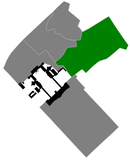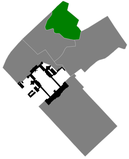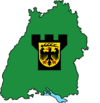Ludwigsburg Palace
| Ludwigsburg Palace | |
|---|---|
Residenzschloss Ludwigsburg | |
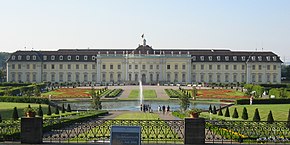 The Neuer Hauptbau and the Blooming Baroque gardens from the south | |
| General information | |
| Location | Ludwigsburg, Germany |
| Coordinates | 48°54′0″N 9°11′45″E / 48.90000°N 9.19583°E |
| Construction started | 1704 |
| Completed | 1733 |
| Cost | 3,000,000 florins |
| Client | House of Württemberg |
| Owner | Baden-Württemberg |
| Website | |
| www | |
Ludwigsburg Palace, nicknamed the "Versailles of Swabia",[1] is a 452-room palace complex of 18 buildings located in Ludwigsburg, Baden-Württemberg, Germany. Its total area, including the gardens, is 32 ha (79 acres) – the largest palatial estate in the country. The palace has four wings: the northern wing, the Alter Hauptbau, is the oldest and was used as a ducal residence; the east and west wings were used for court purposes and housing guests and courtiers; the southern wing, the Neuer Hauptbau, was built to house more court functions and was later used as a residence.
The constitutions of the Kingdom and Free People's State of Württemberg were ratified at Ludwigsburg Palace, in 1819 and 1919 respectively. It was the residence for four of Württemberg's monarchs and some other members of the House of Württemberg and their families. The palace was opened to the public in 1918 and survived World War II intact. It underwent periods of restoration in the 1950s, 1960s, and 1990s and again for the palace's 300th anniversary in 2004. The palace had more than 350,000 visitors in 2017 and has hosted the Ludwigsburg Festival every year since 1947.
Surrounding the palace are the Blooming Baroque (Blühendes Barock) gardens, arranged in 1954 as they might have appeared in 1800. Nearby is Schloss Favorite, a hunting lodge built in 1717 by Frisoni. Within the palace are two museums operated by the Landesmuseum Württemberg dedicated to fashion and porcelain respectively.
History

"Ludwigsburg", meaning "Louis's castle", was named after its builder,
Construction of Ludwigsburg Palace had officially begun in May 1704 with the laying of the Alter Hauptbau's cornerstone by Eberhard Louis.[2] The year before, he sent Philipp Joseph Jenisch to study architecture abroad, and himself studied architecture while staying at Nymphenburg. Upon Jenisch's return the next year, Eberhard Louis appointed director of construction. Jenisch, however, only managed to finish the Alter Hauptbau's (Old main building) first floor and some of the southern garden before falling out of the duke's favor in 1707.[3][13][14] Jenisch was replaced in 1707 with Johann Friedrich Nette, an engineer.[3][14] By 1709, it had become apparent that the massive undertaking of the palace's construction eventually necessitated the building of a town, also known as Ludwigsburg.[15][16] That cost of construction provoked financial consequences, opposition at court, and criticism from the populace.[17]
Construction

Nette was now charged with building a complete Baroque palace from Jenisch's central corps de logis, to which an east wing and a west wing were to be added, aligned at 11°. Nette based his plans on those of Jenisch, enabling him to complete his design for a three-wing palace in the same year as his appointment. The galleries of the Alter Hauptbau were completed in 1707, then the corps de logis the next year. The Ordensbau and Riesenbau were constructed from 1709 to 1713, and their interiors were completed in 1714. Nette began the interior of the Alter Hauptbau, which he would never finish. Construction of the building's pavilions dragged on into 1722.[3][18] Nette made two trips to Prague and his native Brandenburg to expand his pool of talent. He hired Johann Jakob Stevens von Steinfels, Tomasso Soldati, and Donato Giuseppe Frisoni in 1708, Andreas Quitainner in 1709, and then Luca Antonio Colomba, Riccardo Retti and Diego Francesco Carlone. Nette fled to Paris from an accusation of embezzlement from Jenisch's allies but was ordered back to Ludwigsburg by Eberhard Louis. On his return trip, he died suddenly of a stroke on 9 December 1714 in Nancy at the age of 41. At the time of his death, most of the northern section of the modern palace and its northern garden was complete.[3][19]
Eberhard Louis stunted an attempt by Jenisch to reprise his previous role as director, replacing Nette in 1715 with Frisoni.[20] Frisoni, although having no formal training in architecture, enjoyed the support of the court chamberlain and impressed the duke with his stucco work in the Alter Hauptbau.[3][21] Frisoni resumed construction with the palace's churches, beginning the Schlosskapelle in 1716 and the Ordenskapelle in 1720, then finished the Kavalierbauten in 1722.[22][23] Frisoni also added the mansard roof to the top of the Alter Hauptbau, as its flat roof was prone to water damage. This had become a common issue with Nette's work because of the pressure the duke placed on him to finish the palace as soon as possible.[24][25] Frisoni's work thus far led him to believe that he did not have a large enough talent pool to satisfy the duke's desires for the palace and town, so Frisoni brought in Giacomo Antonio Corbellini and Paolo Retti, his brother and son-in-law respectively, who were followed by Diego Francesco Carlone in 1718.[3]
In 1721, the duke began to run out of room in the Alter Hauptbau for the functions of his court and Frisoni began planning to enlarge it.
Residence

Eberhard Louis left no heirs and was succeeded by Charles Alexander.[31] Charles Alexander ended funding for the palace, dismissed its staff, and moved the capital back to Stuttgart in 1733 to modernize Württemberg's army and fortifications.[3][28] As central figures in the construction of what was now decried as the "sin palace", Frisoni and Paolo Retti were arrested in 1733 on fraudulent charges of embezzlement. The two men were acquitted in 1735 after they paid a hefty fine to the ducal treasury, despite attempted intervention by Charles William Frederick, Margrave of Brandenburg-Ansbach to free them earlier. Frisoni died in Ludwigsburg on 29 November 1735.[20][32] Charles Alexander himself died suddenly two years later on 12 March 1737 as he prepared to leave Ludwigsburg Palace to inspect the duchy's fortresses. After his death, the nine-year-old Charles Eugene became Duke, beginning a regency that lasted until 1744.[33]
Charles Eugene began the construction of a

Napoleon's armies occupied Württemberg from 1800 to 1801, forcing the duke and duchess to flee to Vienna. The royals returned when Frederick II agreed in 1803 to pledge allegiance to Napoleon and part with Württemberg's territory on the Left Bank of the Rhine, an area of 388 square kilometers (150 sq mi). In exchange, according to the Treaty of Lunéville, Frederick II was named a Prince-elector and given 1,609 square kilometers (621 sq mi) of mediatised Right Bank territory.[38][39] Frederick II, now Elector Frederick I, tasked his court architect Nikolaus Friedrich von Thouret with renovating the palace in the Neoclassical style. Thouret started in the Ahengalerie and the Ordensbau, working there from 1803 to 1806.[40] For two days in October 1805,[41] Napoleon visited Ludwigsburg to coerce Frederick I into joining the Confederation of the Rhine and thus becoming his ally,[42] compensating Württemberg with neighboring territories in the Holy Roman Empire and Frederick I with the title of king.[40] Frederick I again tasked Thouret with a remodeling, from 1808 to 1811, of the Ordenskapelle and the king's apartment. The final modernizations ordered by the king took place from 1812 to 1816 in the Schlosstheater and Marble Hall. During this time, the ceiling frescoes of the Guard Room and the main staircases of the Neuer Hauptbau were repainted. By the time Frederick I died in 1816, the majority of the palace had been converted to reflect the latest style.[43]
Following her husband's death, Charlotte continued to reside at Ludwigsburg, receiving visitors such as her siblings.
Later history
In 1817, ownership of Ludwigsburg Palace passed from the

On 9 November 1918, the Kingdom of Württemberg was dissolved with the abdication of King William II. Ludwigsburg Palace was opened to the public that same year and a new constitution was ratified for the Free People's State of Württemberg on 12 January 1919.[47][48] At this time, two apartments at Ludwigsburg Palace were still occupied by members of the House of Württemberg, Duke Ulrich and Princess Olga. The new state ordered them vacated until 1 April for the ratification. Ulrich moved out of Ludwigsburg in January, but Olga rented a new suite in the Neuer Hauptbau in February. She continued to reside at Ludwigsburg in her apartment with her family until her death in 1932.[47]
The Schlosstheater hosted the
Restorations were undertaken in the 1950s and 1960s and again in the 1990s, in time for the palace's tricentenary in 2004. The anniversary was commemorated by the state government with three new museums.
In 2017, 350,642 people visited Ludwigsburg Palace.[62] By March 2020,[63] Staatliche Schlösser und Gärten Baden-Württemberg plans to have spent €4 million to furnish the Neuer Hauptbau as it would have been during the reign of King Frederick I. To this end, about 500 paintings, 400 pieces of furniture, and 500 lamps, clocks, and sculptures – will be sourced, sorted, and restored.[60][61]
As a result of the
Architecture

Ludwigsburg Palace's Baroque architecture was built under Eberhard Louis from 1704 to 1733 and is characterized by a great deal of Austrian and Czech Baroque influence.[66][67] This is most evident in the two churches, which resemble the Hospital Church of Kuks and the Sanctuary Church of Steyr. The palace's two Baroque architects, Johann Friedrich Nette and Donato Frisoni, were educated and worked in Bohemia and hired staff experienced in the Bohemian style. Frisoni even knew or was related to some of the artisans who worked at the Steyr church.[3][20] French influence is also present, for example in the mirror halls in both the corps de logis and the palace's many mansard roofs. The combination of work by Germans (Philipp Jenisch and Nette) and Italians (Frisoni, Diego and Carlo Carlone, Giuseppe Baroffio, Scotti and Luca Antonio Colomba) produced a strong resemblance to late 17th century works in Prague and Vienna.[24][68] Charles Eugene brought the Rococo style to Ludwigsburg in 1747 and his court architect, Philippe de La Guêpière, worked in that style until 1775.[34]
North wing (Alter Hauptbau)

The north wing, referred to as the Alter Hauptbau (Old Main building), is the oldest portion of the palace. It was originally built to house the apartments of Eberhard Louis and
The two pavilions to the west and east of the corps de logis are connected to it by arcaded galleries, completed in 1713 and 1715 respectively, that close off the northern edge of the
East wing

The first structure of the eastern wing is the Riesenbau (Giants' building), built by Johann Friedrich Nette in 1712–13. The
Directly south of the Riesenbau is the Östlicher Kavalierbau (East Cavaliers' Building), built from 1715 to 1719 for housing

The Schlosskapelle (Palace chapel) was built from 1716 to 1724. The chapel is made up of a
The southernmost part of the east wing is the
West wing

The first building of the west wing is the Ordensbau (Order building, in reference to the ducal
Immediately southwest of the Ordensbau is the oval Ordenskapelle (Order chapel), built from 1715 to 1723. The Ordenskapelle was remodeled from 1746 to 1748 by
The Westlicher Kavalierbau (West Cavaliers' building) is attached to the Ordenskapelle, identical in layout and design to its eastern counterpart. It was built in 1719–20, and retains some original stucco and ceiling frescoes by Riccardo and Retti. The Festinbau, attached to the Westlicher Kavalierbau, was originally designed as a kitchen built from 1729 to 1733, and used from 1770 to 1775 as a theater. Since 2004, the Westlicher Kavalierbau and Festinbau have housed a
The Bildergalerie (Picture gallery), the southernmost part of the west wing, was built by Frisoni in 1731–32. The only remaining Baroque decor is Scotti's ceiling fresco depicting the life of Achilles, which first adorned the ceiling of the Ahnengalerie. Thouret renovated the Bildergalerie in Tuscan Neoclassicism from 1803 to 1805, adding a fireplace by Isopi and a statue of Apollo opposite it. The frescoes in the Bildergalerie's antechambers were painted in 1730 by either Scotti or Carlo Carlone.[91][92]
South wing (Neuer Hauptbau)
The south wing, the Neuer Hauptbau (New Main building), was designed and constructed by Frisoni on the order of Duke Eberhard Louis, who found that the Alter Hauptbau was too small to serve the needs of his court. Frisoni planned for a four-story building in 1725 but wound up building three stories. Eberhard Louis died before he could move into the Neuer Hauptbau, leaving its interiors unfinished until Duke Charles Eugene finished them in 1747, but abandoned the palace in 1775. The next royals to reside there were Württemberg's first King and Queen, Frederick I and

The Neuer Hauptbau opens with an oval vestibule decorated by Carlo Carlone. It houses a statue of Duke Eberhard Louis, surrounded by
Two galleries lead from the stairs to a guardroom decorated by Diego Carlone in 1730 with stucco weapon trophies and fresco. Thouret covered over Carlone's work with Neoclassical ornamentation in 1815. The guardroom leads into the Marble Hall (Marmorsaal), the palatial

To the east of the Marble Hall is Queen Charlotte's apartment, originally the suites intended to house Prince

The king's apartment, to the west of Charlotte's, was to house Duke Eberhard Louis and Wilhelmine von Grävenitz, and later
Duke Charles Eugene moved into the Neuer Hauptbau in 1757 and tasked La Guêpière with the apartment's decoration. Two years later, La Guêpière completed the entire suite except for the bedchamber, as the Duke occupied his wife's former suite in 1760 for his actual residence. The rest of the suite was used for social functions until it was emptied of furnishings in the next decade. A staircase and antechamber lead to the entrance of today's apartment, a gallery decorated by Ludovico Bossi. The initial rooms are the first and second antechambers, clad in green damask with
Grounds and gardens

The gardens were to be centered in the north with an Italian terraced garden and were largely completed when Eberhard Louis turned his attention to the south garden. There he laid out a large symmetrical

In 1947,
Schloss Favorite
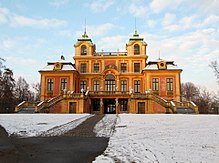
By 1710 Eberhard Louis had decided to use Ludwigsburg as his main residence, but he still desired a hunting retreat. Inspired by a garden palace he had seen in Vienna, he tasked Frisoni with the design of a new Rococo palace on a hill to the north of Ludwigsburg.[115] Frisoni largely completed Favorite within that year[116] but was unable to complete his extensive plans for its grounds. Only the roads to the main palace and to Monrepos Palace were laid out. In 1800, the interior was remodeled by Thouret for Frederick I.[117] Only one room, in the western half of the building, retains its original baroque appearance.[118] When Frederick was appointed an elector in 1803 and then a king in 1806, he chose both times to celebrate the occasion at Schloss Favorite.[119] Favorite fell into disrepair in the 20th century but was extensively restored from 1972 to 1982.[120]
Museums
On the first and third floors of the Alter Hauptbau is the Baroque Gallery (Barockgalerie),

The
On the ground floor of the Neuer Hauptbau is a lapidarium, housing original Baroque statuary by Andreas Quittainer, Johann Wilhelm Beyer and Pierre François Lejeune.[132] Charles Eugene's apartment houses the Princess Olga Cabinet Exhibition, exploring the lives of Princess Olga and her family at Ludwigsburg from 1901 to 1932.[133]
Kinderreich (Children's Kingdom) is an interactive museum that educates children four years and older about life at the court of the
See also
Citations
- ^ Dorling 2001, p. 292.
- ^ a b Wenger 2004, p. 3.
- ^ a b c d e f g h i j k l m Süddeutscher Barock: Ludwigsburg.
- ^ Wilson 1995, pp. 139, 140.
- ^ Owens 2011, pp. 166–67.
- ^ Wilson 1995, p. 140.
- ^ a b Kaufmann 1995, p. 320.
- ^ Owens 2011, p. 167.
- ^ Owens 2011, p. 168.
- ^ Wilson 1995, pp. 28, 141.
- ^ Blanning 2002, p. 58.
- ^ a b Wilson 1995, pp. 28–29.
- ^ Wenger 2004, pp. 3, 4.
- ^ a b Hempel 1965, p. 171.
- ^ Owens 2011, p. 175.
- ^ Ludwigsburg Museum.
- ^ Wilson 1995, p. 128.
- ^ Wenger 2004, pp. 4, 12, 35.
- ^ Süddeutscher Barock: Johann Friedrich Nette.
- ^ a b c Ludwigsburg Palace: Donato Giuseppe Frisoni.
- ^ Hempel 1965, p. 172.
- ^ a b Ludwigsburg Palace: Die Gebäude.
- ^ Wenger 2004, p. 5.
- ^ a b c d Ludwigsburg Palace: Die Dächer.
- ^ Wenger 2004, p. 6.
- ^ Wenger 2004, pp. 6–7.
- ^ a b Ludwigsburg Palace: Der Neue Hauptbau.
- ^ a b Wenger 2004, p. 7.
- ^ Wilson 1995, p. 36.
- ^ a b Stuttgarter Zeitung, 28 November 2014.
- ^ Wilson 1995, p. 165.
- ^ Süddeutscher Barock: Donato Giuseppe Frisoni.
- ^ Wilson 1995, p. 184.
- ^ a b Wenger 2004, pp. 7–8.
- ^ Ludwigsburg Palace: Das Appartement von Herzog Carl Eugene.
- ^ a b c Wenger 2004, p. 8.
- ^ a b c Ludwigsburg Palace: Das Schlosstheater.
- ^ a b Curzon 2016, p. 70.
- ^ Ludwigsburg Palace: Württemberg wird Königreich.
- ^ a b Wenger 2004, p. 9.
- ^ Hazlitt 1830, p. 143.
- ^ Ludwigsburg Palace: Friedrich I von Württemberg.
- ^ Wenger 2004, pp. 9–10.
- ^ Curzon 2016, pp. 70–71.
- ^ a b Wenger 2004, pp. 10–11.
- ^ Panton 2011, p. 103.
- ^ a b c Ludwigsburg Palace: Das Ende der Monarchie.
- ^ a b c d Ludwigsburg Palace: Ordensbau und Ordenskapelle.
- ^ a b c Wenger 2004, p. 11.
- ^ a b Ludwigsburg Festival: Chronicle.
- ^ Stuttgarter Zeitung, 26 August 2015.
- ^ Weingartner 2011, p. 49.
- ^ Ludwigsburg: Charles de Gaulle.
- ^ Stuttgarter Zeitung, 8 September 2012a.
- ^ Südwest Presse, 10 August 2016.
- ^ US Army, 27 October 2011.
- ^ Ministry of Finance: Sondermarken Februar 2017.
- ^ Stuttgarter Zeitung, 8 September 2012b.
- ^ Euronews, 22 September 2012.
- ^ a b Stuttgarter Nachrichten, 17 November 2017.
- ^ a b BaWü Ministry of Finance: Finanzministerin besucht Residenzschloss Ludwigsburg.
- ^ Stuttgarter Nachrichten, 6 February 2018.
- ^ SWP.de, 25 May 2018.
- ^ "Important information about the Coronavirus". Staatliche Schlösser und Gärten Baden-Württemberg. Archived from the original on 18 April 2020. Retrieved 18 April 2020.
- ^ "Gradual opening of our monuments". Staatliche Schlösser und Gärten Baden-Württemberg. Archived from the original on 25 May 2020. Retrieved 25 May 2020.
- ^ Ludwigsburg Palace: Stilgeschichte.
- ^ Wenger 2004, pp. 3–6.
- ^ Kaufmann 1995, p. 321–22.
- ^ Wenger 2004, pp. 8–10.
- ^ a b Ludwigsburg Palace: Der Alte Hauptbau.
- ^ Wenger 2004, pp. 12–13.
- ^ Wenger 2004, pp. 13, 16–17, 18.
- ^ Wenger 2004, pp. 23–24.
- ^ Wenger 2004, pp. 24–28.
- ^ Ludwigsburg Palace: Der Jagdpavillon.
- ^ Wenger 2004, pp. 28–30.
- ^ Ludwigsburg Palace: Der Spielpavillon.
- ^ Wenger 2004, pp. 35–41.
- ^ Wenger 2004, pp. 48–49, 91, 92–93.
- ^ BaWü Ministry of Tourism: Ludwigsburg Residential Palace.
- ^ SWP.de, 15 January 2018.
- ^ Ludwigsburg Palace: Die Schlosskapelle.
- ^ Wenger 2004, pp. 43–45.
- ^ Wenger 2004, pp. 84–87.
- ^ Ludwigsburg Palace: Die Ahnengalerie.
- ^ Wenger 2004, pp. 31–34.
- ^ Ludwigsburg Palace: Meilensteine.
- ^ Wenger 2004, pp. 46–48.
- ^ Wenger 2004, pp. 48, 49, 90.
- ^ Ludwigsburg Palace: Der Küchenbau.
- ^ Wenger 2004, pp. 84, 88–90.
- ^ Ludwigsburg Palace: Die Bildergalerie.
- ^ Wenger 2004, pp. 6, 8, 11, 50, 65–66.
- ^ Wenger 2004, pp. 51–53.
- ^ Wenger 2004, pp. 54–56.
- ^ Ludwigsburg Palace: Der Marmorsaal.
- ^ Wenger 2004, pp. 66–74.
- ^ Ludwigsburg Palace: Das Appartement der Königin.
- ^ Ludwigsburg Palace: Charlotte Mathilde von Württemberg.
- ^ Wenger 2004, pp. 56–64.
- ^ Ludwigsburg Palace: Das Appartement des Königs.
- ^ Wenger 2004, pp. 75–83.
- ^ a b Ludwigsburg Palace: Der Garten.
- ^ Blooming Baroque: South Garden (Südgarten).
- ^ Blooming Baroque: North Garden (Nordgarten).
- ^ a b Blooming Baroque: History of the Ludwigsburg Palace Garden.
- ^ Blooming Baroque: Lower East Garden (Unterer Ostgarten).
- ^ Blooming Baroque: Upper East Garden (Obere Ostgarten).
- ^ Blooming Baroque: Emichsburg castle.
- ^ a b Blooming Baroque: Albert Schöchle's idea.
- ^ Blooming Baroque: Creation of the Fairy-Tale Garden.
- ^ Blooming Baroque: Another success for Albert Schöchle.
- ^ Blooming Baroque: Facts and Figures.
- ^ Blooming Baroque: General plan.
- ^ Schloss Favorite: Das Schloss und der Garten.
- ^ Süddeutscher Barock: Favorite Ludwigsburg.
- ^ Schloss Favorite: Das Gebäude.
- ^ Schloss Favorite: Die westlichen Zimmer.
- ^ Schloss Favorite: Meilensteine.
- ^ Schloss Favorite: Home.
- ^ Wenger 2004, p. Foldout map.
- ^ Ludwigsburg: Barockgalerie.
- ^ Landeskunde Online: Barockgalerie in Schloss, Intro 1.
- ^ Ludwigsburg Palace: Die Barockgalerie.
- ^ Landeskunde Online: Barockgalerie in Schloss, Intro 2.
- ^ Ludwigsburg Palace: Das Keramikmuseum.
- ^ Landesmuseum Württemberg: Keramikmuseum.
- ^ Ludwigsburg: Keramikmuseum.
- ^ Wenger 2004, pp. 49, 91, Foldout map.
- ^ Ludwigsburg Palace: Das Modemuseum.
- ^ Landesmuseum Württemberg: Modemuseum.
- ^ Ludwigsburg Palace: Das Lapidarium.
- ^ Ludwigsburg Palace: Die Kabinettausstellung Prinzessin Olga.
- ^ Ludwigsburg: Kinderreich Schloss Ludwigsburg.
- ^ Ludwigsburg Palace: Das Kinderreich.
- ^ Ludwigsburg: Junge Bühne.
References
- ISBN 978-0-1982-2745-8.
- Curzon, Catherine (2016). Life in the Georgian Court. ISBN 978-1-4738-4554-1.
- Dorling Kindersley (2001). Eyewitness Travel Guide to Germany. ISBN 978-0-7894-6646-4.
- Hazlitt, William (1830). The Life of Napoleon Buonaparte. Vol. III. Hunt and Clarke.
- Hempel, Eberhard (1965). Baroque Art and Architecture in Central Europe. Penguin Books.
- Kaufmann, Thomas DaCosta (1995). Court, Cloister, and City: The Art and Culture of Central Europe, 1450–1800. ISBN 978-0-226-42729-4.
- Owens, Samantha; Reul, Barbara M.; Stockigt, Janice B., eds. (2011). "The Court of Württemberg-Stuttgart". Music at German Courts, 1715–1760: Changing Artistic Priorities. Foreword by Michael Talbot. ISBN 978-1-84383-598-1.
- Panton, James (2011). Historical Dictionary of the British Monarchy. ISBN 978-0-8108-7497-8.
- Weingartner, James J. (2011). Americans, Germans and War Crimes Justice: Law, Memory and "the Good War". ISBN 978-0-313-38192-8.
- Wenger, Michael (2004). Ludwigsburg Palace: The Interior. ISBN 978-3-422-03100-5.
- Wilson, Peter H. (1995). War, State, and Society in Württemberg, 1677–1793. ISBN 978-0-521-48331-5.
- News sources
- Jones, Capt. Gregory (27 October 2011). "21st TSC Soldiers invited to Minister President's reception". 21st TSC Public Affairs. US Army. Retrieved 17 February 2018.
- Birkenmaier, Werner (8 September 2012). "Unerwartete Herzlichkeit". Stuttgarter Zeitung (in German). Retrieved 29 January 2019.
- Birkenmaier, Werner (8 September 2012). "Gedenkveranstaltungen in Ludwigsburg". Stuttgarter Zeitung (in German). Retrieved 29 January 2019.
- "Leaders remember De Gaulle's seminal speech". Euronews. 22 September 2012. Retrieved 29 January 2019.
- Höhn, Tim (28 November 2014). "Sex, Stars und große Oper". Stuttgarter Zeitung (in German). Retrieved 10 March 2018.
- Lorenz, Hilke (26 August 2015). "Das große Möbelrücken im Schloss". Stuttgarter Zeitung (in German). Retrieved 7 November 2018.
- Szczegulski, Gabriele (10 August 2016). "KSK Music Open in Ludwigsburg werden zur Marke". Bietigherim Zeitung (in German). Südwest Presse. Retrieved 16 December 2017.
- Binkowski, Rafael (17 November 2017). "Rokoko-Meisterwerk ist eine Million Wert". Stuttgarter Nachrichten. Retrieved 7 December 2017.
- Szczegulski, Gabrielle (15 January 2018). "Italiener bringt Glanz nach Ludwigsburg". Bietigheimer Zeitung. Retrieved 30 May 2018.
- Binkowski, Rafael (6 February 2018). "Neuer Besucherrekord auf Schloss Ludwigsburg". Stuttgarter Nachrichten (in German). Retrieved 31 October 2018.
- "Der textile Prunk im Ludwigsburger Schloss". swp.de (in German). 25 May 2018. Retrieved 2 June 2018.
Web sources
- Bühler, Dr. Christoph. "Barockgalerie in Schloss Ludwigsburg" (in German). Badischer Heimet. Retrieved 5 December 2017.
- Bühler, Christoph. "Barockgalerie in Schloss Ludwigsburg" (in German). Badischer Heimet. Retrieved 5 December 2017.
- "Keramikmuseum" (in German). Landesmuseum Württemberg. Retrieved 5 December 2017.
- "Modemuseum" (in German). Landesmuseum Württemberg. Retrieved 5 December 2017.
- German Federal and Baden-Württemberg State governments (in German)
- "Stilgeschichte". Staatliche Schlösser und Gärten Baden-Württemberg. Retrieved 26 February 2018.
- "Meilensteine". Staatliche Schlösser und Gärten Baden-Württemberg. Retrieved 7 June 2018.
- "Württemberg wird Königreich". Staatliche Schlösser und Gärten Baden-Württemberg. Retrieved 29 January 2019.
- "Das Ende der Monarchie". Retrieved 29 January 2019.
- "Die Gebäude". Staatliche Schlösser und Gärten Baden-Württemberg. Retrieved 5 December 2017.
- "Der Alte Hauptbau". Staatliche Schlösser und Gärten Baden-Württemberg. Retrieved 5 December 2017.
- "Der Jagdpavillon". Staatliche Schlösser und Gärten Baden-Württemberg. Retrieved 5 December 2017.
- "Der Spielpavillon". Staatliche Schlösser und Gärten Baden-Württemberg. Retrieved 5 December 2017.
- "Ordensbau und Ordenskapelle". Staatliche Schlösser und Gärten Baden-Württemberg. Retrieved 5 December 2017.
- "Der Neue Hauptbau". Staatliche Schlösser und Gärten Baden-Württemberg. Retrieved 5 December 2017.
- "Der Marmorsaal". Staatliche Schlösser und Gärten Baden-Württemberg. Retrieved 14 December 2017.
- "Das Appartement des Königs". Staatliche Schlösser und Gärten Baden-Württemberg. Retrieved 16 December 2017.
- "Das Appartement der Königin". Staatliche Schlösser und Gärten Baden-Württemberg. Retrieved 17 December 2017.
- "Das Appartement von Herzog Carl Eugene". Staatliche Schlösser und Gärten Baden-Württemberg. Retrieved 14 December 2017.
- "Die Schlosskapelle". Staatliche Schlösser und Gärten Baden-Württemberg. Retrieved 10 March 2018.
- "Die Bildergalerie". Staatliche Schlösser und Gärten Baden-Württemberg. Retrieved 18 December 2017.
- "Die Ahnengalerie". Staatliche Schlösser und Gärten Baden-Württemberg. Retrieved 17 December 2017.
- "Das Schlosstheater". Staatliche Schlösser und Gärten Baden-Württemberg. Retrieved 5 December 2017.
- "Der Küchenbau". Staatliche Schlösser und Gärten Baden-Württemberg. Retrieved 7 June 2016.
- "Der Garten". Staatliche Schlösser und Gärten Baden-Württemberg. Retrieved 27 June 2018.
- "Die Dächer". Staatliche Schlösser und Gärten Baden-Württemberg. Retrieved 5 December 2017.
- "Friedrich I. von Württemberg". Staatliche Schlösser und Gärten Baden-Württemberg. Retrieved 16 December 2017.
- "Charlotte Mathilde von Württemberg". Staatliche Schlösser und Gärten Baden-Württemberg. Retrieved 13 June 2018.
- "Donato Giuseppe Frisoni". Staatliche Schlösser und Gärten Baden-Württemberg. Retrieved 5 December 2017.
- "Die Barockgalerie". Staatliche Schlösser und Gärten Baden-Württemberg. Retrieved 5 December 2017.
- "Das Keramikmuseum". Staatliche Schlösser und Gärten Baden-Württemberg. Retrieved 5 December 2017.
- "Das Modemuseum". Staatliche Schlösser und Gärten Baden-Württemberg. Retrieved 5 December 2017.
- "Das Lapidarium". Staatliche Schlösser und Gärten Baden-Württemberg. Retrieved 5 December 2017.
- "Die Kabinettausstellung Prinzessin Olga". Baden-Staatliche Schlösser und Gärten Baden-Württemberg. Retrieved 14 December 2017.
- "Das Kinderreich". Staatliche Schlösser und Gärten Baden-Württemberg. Archived from the original on 2017-11-03. Retrieved 5 December 2017.
- "Das Schloss und der Garten". Staatliche Schlösser und Gärten Baden-Württemberg. Retrieved 5 December 2017.
- "Meilensteine". Staatliche Schlösser und Gärten Baden-Württemberg. Retrieved 5 December 2017.
- "Das Gebäude". Staatliche Schlösser und Gärten Baden-Württemberg. Retrieved 5 December 2017.
- "Home". Staatliche Schlösser und Gärten Baden-Württemberg. Retrieved 5 December 2017.
- "Die westlichen Zimmer". Staatliche Schlösser und Gärten Baden-Württemberg. Retrieved 5 December 2017.
- "Sondermarken Februar 2017". Federal Ministry of Finance. Retrieved 14 June 2018.
- "Finanzministerin besucht Residenzschloss Ludwigsburg". Baden-Württemberg Ministry of Finance. 17 November 2017. Retrieved 8 January 2018.
- "Ludwigsburg Residential Palace". Baden-Württemberg Ministry of Tourism. Archived from the original on 14 February 2018. Retrieved 14 February 2018.
- City of Ludwigsburg
- "Chronicle". Ludwigsburg Festival. Retrieved 5 December 2017.
- "Ideal city". City of Ludwigsburg. Retrieved 5 December 2017.
- "Barockgalerie" (in German). City of Ludwigsburg. Retrieved 6 June 2018.
- "Keramikmuseum" (in German). City of Ludigsburg. Retrieved 6 June 2018.
- "Kinderreich Schloss Ludwigsburg" (in German). City of Ludwigsburg. Retrieved 5 December 2017.
- "Junge Bühne" (in German). City of Ludwigsburg. Retrieved 5 December 2017.
- "Facts and Figures". Blühendes Barock. City of Ludwigsburg. Retrieved 27 June 2018.
- "South Garden (Südgarten)". Blühendes Barock. City of Ludwigsburg. Retrieved 27 June 2018.
- "North Garden (Nordgarten)". Blühendes Barock. City of Ludwigsburg. Retrieved 27 June 2018.
- "History of the Ludwigsburg Palace Garden". Blühendes Barock. City of Ludwigsburg. Retrieved 27 June 2018.
- "Lower East Garden (Unterer Ostgarten)". Blühendes Barock. City of Ludwigsburg. Retrieved 27 June 2018.
- "Upper East Garden (Obere Ostgarten)". Blühendes Barock. City of Ludwigsburg. Retrieved 27 June 2018.
- "Emichsburg castle". Blühendes Barock. City of Ludwigsburg. Retrieved 28 June 2018.
- "Albert Schöchle's idea of Blühendes Barock (Baroque in Bloom)". Blühendes Barock. City of Ludwigsburg. Retrieved 27 June 2018.
- "Creation of the Fairy-Tale Garden". Blühendes Barock. City of Ludwigsburg. Retrieved 28 June 2018.
- "Another success for Albert Schöchle". Blühendes Barock. City of Ludwigsburg. Retrieved 28 June 2018.
- "General plan". Blühendes Barock. City of Ludwigsburg. Retrieved 1 September 2018.
- "Charles de Gaulle: The speech". It's Our Europe!. City of Ludwigsburg. Retrieved 29 January 2019.
- Süddeutscher Barock (in German)
- Bieri, Pius. "Residenz Ludwigsburg". Archived from the original on 6 June 2020. Retrieved 20 December 2017.
- Bieri, Pius. "Favorite Ludwigsburg". Archived from the original on 28 June 2018. Retrieved 5 December 2017.
- Bieri, Pius. "Johann Friedrich Nette". Archived from the original on 30 June 2018. Retrieved 5 December 2017.
- Bieri, Pius. "Donato Giuseppe Frisoni". Archived from the original on 16 June 2018. Retrieved 19 January 2018.







